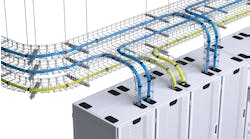The Goldilocks Solution for Healthcare Data Centers Pushed Off-Premise
Anthony Bolner, Executive Vice President and Partner at Stream Data Centers, shares how IT infrastructure leaders at large healthcare enterprises are finding a ‘just-right’ solution in build-to-suit with a provider flexible to their requirements.
Anthony Bolner, EVP of Stream Data Centers
IT infrastructure leaders at healthcare enterprises are being pushed out of their on-premises data centers. This was a trend even before COVID-19 as demand for healthcare services rose year after year and providers had to find more space for care delivery. Now the trend has accelerated, in large part due to “skyrocketing” demand for telehealth services which, according to research by McKinsey and JLL, “increases overall care demand, enhancing the need for healthcare real estate.” That might sound counterintuitive but telehealth requires physical space for care provider suites and diagnostic equipment, in addition to the physical space required by more patients, and by COVID-era social distancing rules.
There’s also an economic driver pushing healthcare data centers off-prem: “There’s an opportunity to convert physical data center space that’s inside of a hospital into revenue-generating space, rather than space that costs the organization money,” explained Rob Faix, a vice president at Impact Advisors, a healthcare IT consulting firm.
What’s next: Self-build, build-to-suit, multi-tenant colocation?
As they’re pushed out of existing on-prem data centers, healthcare enterprise IT infrastructure leaders and their partners in corporate real estate have to decide what comes next. One option is another self-build. Alternatives include leasing multi-tenant space from a colocation provider, or hiring a company to build a data center to suit.
Many healthcare enterprise IT infrastructure leaders are initially reluctant to go to multi-tenant colocation, and tend to lean towards self-build or build-to-suit. For these leaders, the data center is like a utility: No one pays attention to it unless it doesn’t work or there’s a surprisingly high bill. Their primary incentive is to keep the data center up at practically all costs to meet the business’s zero defect expectation – and these leaders know well how to do that on-premise.
“Healthcare tends to be one of the industries that has been a little more traditional, so many of those institutions will want to stay with enterprise [on-premises] data centers,” explained Jackson Metcalf, global critical facilities practice leader with architecture firm Gensler. But “it’s a question of whether [healthcare] can afford to stay with enterprise [on-premises].”
4 Questions to Ask when Considering What’s Next
When we’re talking with healthcare enterprise IT infrastructure leaders and/or their partners in corporate real estate about the change from an on-prem model, we typically discuss four questions. Their answers shed light on the likely best solution for that particular organization.
- What’s the total cost of ownership (TCO) for each option?
An in-house development project is almost always the most expensive option compared to multi-tenant colocation or a build-to-suit. My colleague Chris Bair has a good analogy: “If instead of building a data center, we were building an off-road vehicle, self-build customers might look to build a Range Rover. Stream prefers to build Toyota Land Cruisers. The two vehicles do the same thing but one of them costs less, lasts longer and is easier to maintain and operate; while the other has a lot of bells and whistles.”
The cost difference is often quite significant. In our experience working with relatively conservative, highly regulated self-builders, the TCO on leasing build-to-suit capacity versus building their own is not even close. In one case, for example, the total cost for a 15-year build-to-suit lease was about one-third the estimated construction cost for a self-build.
- How agile do you need to be over the next 20 years?
A self-built data center is a significant capital expense that typically gets amortized over 20 years. The length of the commitment makes it hard to understand and account for the impact of new technologies on the data center. In contrast, leasing capacity from a data center provider – whether a build-to-suit or multi-tenant colocation – is typically a much shorter commitment that gives IT leaders the agility to take advantage of new opportunities as they arise over time.
Healthcare enterprises have only just begun to fully leverage technologies like AI and IoT; who knows what new technologies will be developed over the next two decades. Given the inevitable technological changes we can’t yet predict, many healthcare CIOs are indeed looking to allow significant flexibility for adaptation well before a two-decade amortization schedule is up.
- What’s your tolerance for change?
Moving out of an on-prem facility, no matter where the move it to, is a significant change. Between the options of self-build, build-to-suit, and multi-tenant colocation, self-build is certainly the most familiar to healthcare enterprise IT infrastructure leaders. But if TCO and flexibility point towards build-to-suit as the best option, it doesn’t have to be more disruptive – when it’s with a provider that will flex to your requirements.
Gensler’s Jackson Metcalf puts it well: “A purpose-built colocation facility for healthcare really seems like an appealing type of solution for a lot of the hospitals out there. It offsets their capital expenditure costs significantly. Many have wanted to move to colocation, but have struggled to wrap their heads around how to do it in a way that makes them comfortable as an institution.”
Not too long ago, I was leading a tour of our Dallas data center with the IT infrastructure and corporate real estate leaders of a $10 billion healthcare provider. Walking one of the data halls, the head of IT infrastructure said to me, “We could never not be on-premises, but if we did, we’d come here.” Just a few months later, he came back, having been told by the CFO there was no way he’d get the budget for a self-build. We ended up doing a build-to-suit for them, with dedicated infrastructure including dedicated fiber vaults. The head of IT infrastructure told us, “It isn’t on-prem, but it’s pretty darn close.”
- Is there a data center company with a history of flexibility in building and operations?
As the head of IT infrastructure at that $10 billion healthcare provider found, a build-to-suit engagement with Stream is the Goldilocks solution – close enough to self-build/self-operate but with the benefits of lower TCO and greater agility. We have many similar examples. Like the large North American bank, for whom we purpose-fit data center design as well as operating procedures. The bank’s leaders said “working with the Stream-provided operations team is about 90% similar to working with our own data center employees.”
Stream is able to provide that right level of purpose-fit because at the same time that we’re a well-established, credible operator, with strong capital partners and 20+ years of experience serving highly regulated Fortune 500 clients, we’re small enough to be flexible for our customers – and the decision makers are at the table from the beginning.
The Goldilocks Solution
The lowest TCO and highest agility option is often multi-tenant colocation, but relative to what a healthcare enterprise IT infrastructure leader is used to, it’s also the least familiar. Build-to-suit with the right provider is an ideal middle ground that offers the TCO benefits and agility of colocation as well as the purpose-fit flexibility that makes it feel quite similar to on-prem.
It’s not home, but it’s close.
Anthony Bolner is Executive Vice President and Partner at Stream Data Centers.





